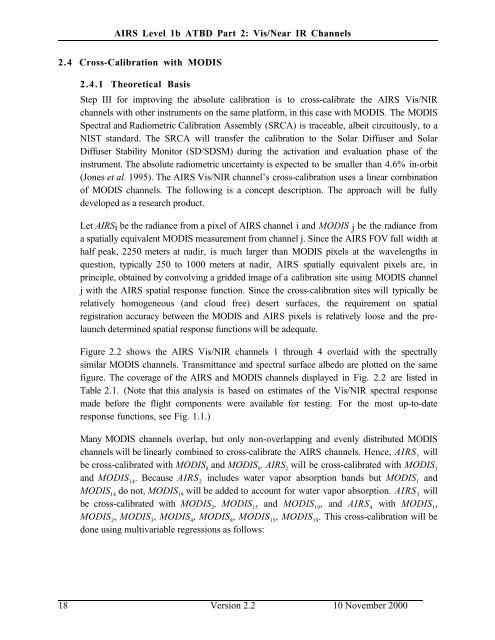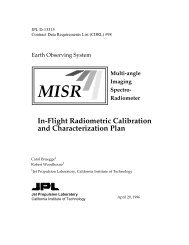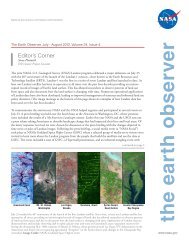AIRS Level 1B Visible/Near-Infrared Channels ATBD - NASA's Earth ...
AIRS Level 1B Visible/Near-Infrared Channels ATBD - NASA's Earth ...
AIRS Level 1B Visible/Near-Infrared Channels ATBD - NASA's Earth ...
You also want an ePaper? Increase the reach of your titles
YUMPU automatically turns print PDFs into web optimized ePapers that Google loves.
<strong>AIRS</strong> <strong>Level</strong> 1b <strong>ATBD</strong> Part 2: Vis/<strong>Near</strong> IR <strong>Channels</strong><br />
2.4 Cross-Calibration with MODIS<br />
2.4.1 Theoretical Basis<br />
Step III for improving the absolute calibration is to cross-calibrate the <strong>AIRS</strong> Vis/NIR<br />
channels with other instruments on the same platform, in this case with MODIS. The MODIS<br />
Spectral and Radiometric Calibration Assembly (SRCA) is traceable, albeit circuitously, to a<br />
NIST standard. The SRCA will transfer the calibration to the Solar Diffuser and Solar<br />
Diffuser Stability Monitor (SD/SDSM) during the activation and evaluation phase of the<br />
instrument. The absolute radiometric uncertainty is expected to be smaller than 4.6% in-orbit<br />
(Jones et al. 1995). The <strong>AIRS</strong> Vis/NIR channel’s cross-calibration uses a linear combination<br />
of MODIS channels. The following is a concept description. The approach will be fully<br />
developed as a research product.<br />
Let <strong>AIRS</strong>i be the radiance from a pixel of <strong>AIRS</strong> channel i and MODIS j be the radiance from<br />
a spatially equivalent MODIS measurement from channel j. Since the <strong>AIRS</strong> FOV full width at<br />
half peak, 2250 meters at nadir, is much larger than MODIS pixels at the wavelengths in<br />
question, typically 250 to 1000 meters at nadir, <strong>AIRS</strong> spatially equivalent pixels are, in<br />
principle, obtained by convolving a gridded image of a calibration site using MODIS channel<br />
j with the <strong>AIRS</strong> spatial response function. Since the cross-calibration sites will typically be<br />
relatively homogeneous (and cloud free) desert surfaces, the requirement on spatial<br />
registration accuracy between the MODIS and <strong>AIRS</strong> pixels is relatively loose and the prelaunch<br />
determined spatial response functions will be adequate.<br />
Figure 2.2 shows the <strong>AIRS</strong> Vis/NIR channels 1 through 4 overlaid with the spectrally<br />
similar MODIS channels. Transmittance and spectral surface albedo are plotted on the same<br />
figure. The coverage of the <strong>AIRS</strong> and MODIS channels displayed in Fig. 2.2 are listed in<br />
Table 2.1. (Note that this analysis is based on estimates of the Vis/NIR spectral response<br />
made before the flight components were available for testing. For the most up-to-date<br />
response functions, see Fig. 1.1.)<br />
Many MODIS channels overlap, but only non-overlapping and evenly distributed MODIS<br />
channels will be linearly combined to cross-calibrate the <strong>AIRS</strong> channels. Hence, <strong>AIRS</strong> 1<br />
will<br />
be cross-calibrated with MODIS 8<br />
and MODIS 9<br />
. <strong>AIRS</strong> 2<br />
will be cross-calibrated with MODIS 1<br />
and MODIS 14<br />
. Because <strong>AIRS</strong> 2<br />
includes water vapor absorption bands but MODIS 1<br />
and<br />
MODIS 14<br />
do not, MODIS 19<br />
will be added to account for water vapor absorption. <strong>AIRS</strong> 3<br />
will<br />
be cross-calibrated with MODIS 2<br />
, MODIS 15<br />
and MODIS 19<br />
, and <strong>AIRS</strong> 4<br />
with MODIS 1<br />
,<br />
MODIS 2<br />
, MODIS 3<br />
, MODIS 4<br />
, MODIS 8<br />
, MODIS 15<br />
, MODIS 19<br />
. This cross-calibration will be<br />
done using multivariable regressions as follows:<br />
18 Version 2.2 10 November 2000







